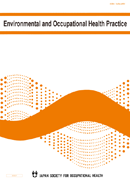Volume 2, Issue 1
Displaying 1-19 of 19 articles from this issue
- |<
- <
- 1
- >
- >|
Perspectives
-
Article type: Perspective
2020Volume 2Issue 1 Article ID: 2020-0010-PR
Published: 2020
Released on J-STAGE: December 25, 2020
Advance online publication: December 09, 2020Download PDF (452K) Full view HTML
Commentaries
-
Article type: Commentary
2020Volume 2Issue 1 Article ID: 2020-0012-CM
Published: 2020
Released on J-STAGE: December 25, 2020
Advance online publication: November 26, 2020Download PDF (371K) Full view HTML
Review Articles
-
Article type: Review
2020Volume 2Issue 1 Article ID: 2020-0005-RA
Published: 2020
Released on J-STAGE: December 25, 2020
Advance online publication: November 05, 2020Download PDF (452K) Full view HTML
Brief Reports
-
Article type: Brief Report
2020Volume 2Issue 1 Article ID: 2020-0009-BR
Published: 2020
Released on J-STAGE: December 25, 2020
Advance online publication: October 14, 2020Download PDF (387K) Full view HTML
Recommendation of occupational exposure limits (2020-2021)
-
2020Volume 2Issue 1 Article ID: ROEL2020
Published: 2020
Released on J-STAGE: September 25, 2020
Advance online publication: September 11, 2020Download PDF (783K) Full view HTML
Review Articles
-
Article type: Review
2020Volume 2Issue 1 Article ID: 2020-0016-RA
Published: 2020
Released on J-STAGE: September 25, 2020
Advance online publication: September 08, 2020Download PDF (556K) Full view HTML
Original Articles
-
Article type: Original Article
2020Volume 2Issue 1 Article ID: 2019-0016-OA
Published: 2020
Released on J-STAGE: September 25, 2020
Advance online publication: July 10, 2020Download PDF (700K) Full view HTML -
Article type: Original Article
2020Volume 2Issue 1 Article ID: 2020-0001-OA
Published: 2020
Released on J-STAGE: September 25, 2020
Advance online publication: June 30, 2020Download PDF (1459K) Full view HTML -
Article type: Original Article
2020Volume 2Issue 1 Article ID: 2020-0007-OA
Published: 2020
Released on J-STAGE: June 30, 2020
Advance online publication: June 15, 2020Download PDF (855K) Full view HTML
Opinions
-
Article type: Opinion
2020Volume 2Issue 1 Article ID: 2020-0008-OP
Published: 2020
Released on J-STAGE: June 30, 2020
Advance online publication: June 15, 2020Download PDF (776K) Full view HTML
Good Practices
-
Article type: Good Practice
2020Volume 2Issue 1 Article ID: 2020-GPS02
Published: 2020
Released on J-STAGE: June 30, 2020
Advance online publication: June 12, 2020Download PDF (852K) Full view HTML -
Article type: Good Practice
2020Volume 2Issue 1 Article ID: 2020-GPS04
Published: 2020
Released on J-STAGE: June 30, 2020
Advance online publication: June 08, 2020Download PDF (1172K) Full view HTML -
Article type: Good Practice
2020Volume 2Issue 1 Article ID: 2020-GPS01
Published: 2020
Released on J-STAGE: June 30, 2020
Advance online publication: June 05, 2020Download PDF (808K) Full view HTML -
Article type: Good Practice
2020Volume 2Issue 1 Article ID: 2020-GPS03
Published: 2020
Released on J-STAGE: June 30, 2020
Advance online publication: June 05, 2020Download PDF (1403K) Full view HTML
Review Articles
-
Article type: Review
2020Volume 2Issue 1 Article ID: 2020-0006-RA
Published: 2020
Released on J-STAGE: June 30, 2020
Advance online publication: June 02, 2020Download PDF (988K) Full view HTML
Original Articles
-
Article type: Original Article
2020Volume 2Issue 1 Article ID: 2020-0002-OA
Published: 2020
Released on J-STAGE: June 30, 2020
Advance online publication: May 15, 2020Download PDF (1115K) Full view HTML -
Article type: Original Article
2020Volume 2Issue 1 Article ID: 2019-0020-OA
Published: 2020
Released on J-STAGE: March 25, 2020
Advance online publication: March 20, 2020Download PDF (1024K) Full view HTML
Editorial
-
Article type: Editorial
2020Volume 2Issue 1 Article ID: 2.1-ED
Published: 2020
Released on J-STAGE: March 25, 2020
Advance online publication: February 12, 2020Download PDF (560K) Full view HTML
Recognition of Reviewers
-
2020Volume 2Issue 1 Article ID: 2.A1
Published: 2020
Released on J-STAGE: December 25, 2020
Download PDF (204K) Full view HTML
- |<
- <
- 1
- >
- >|
